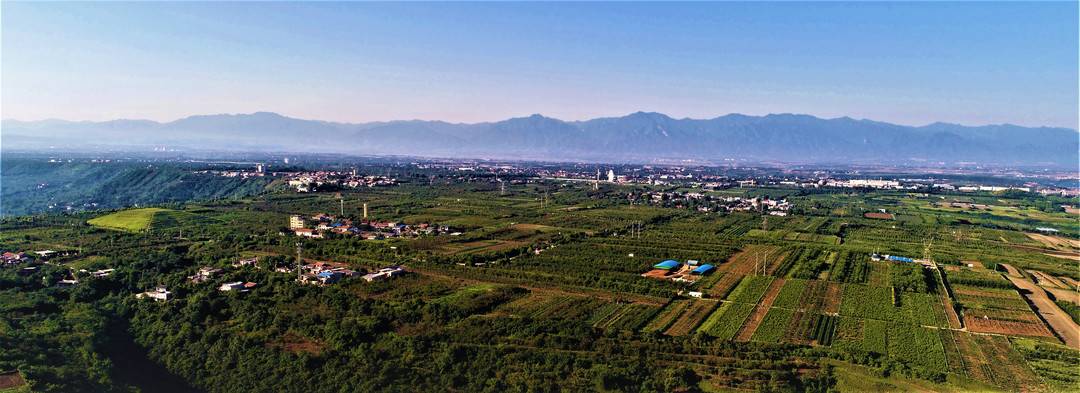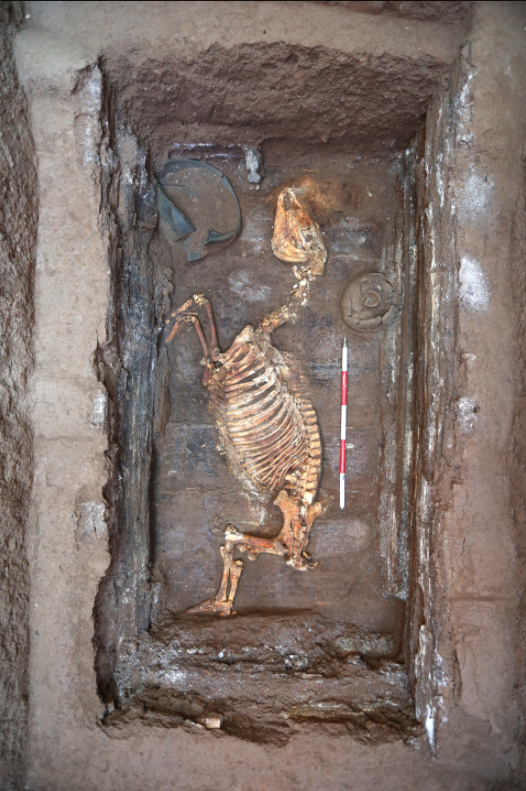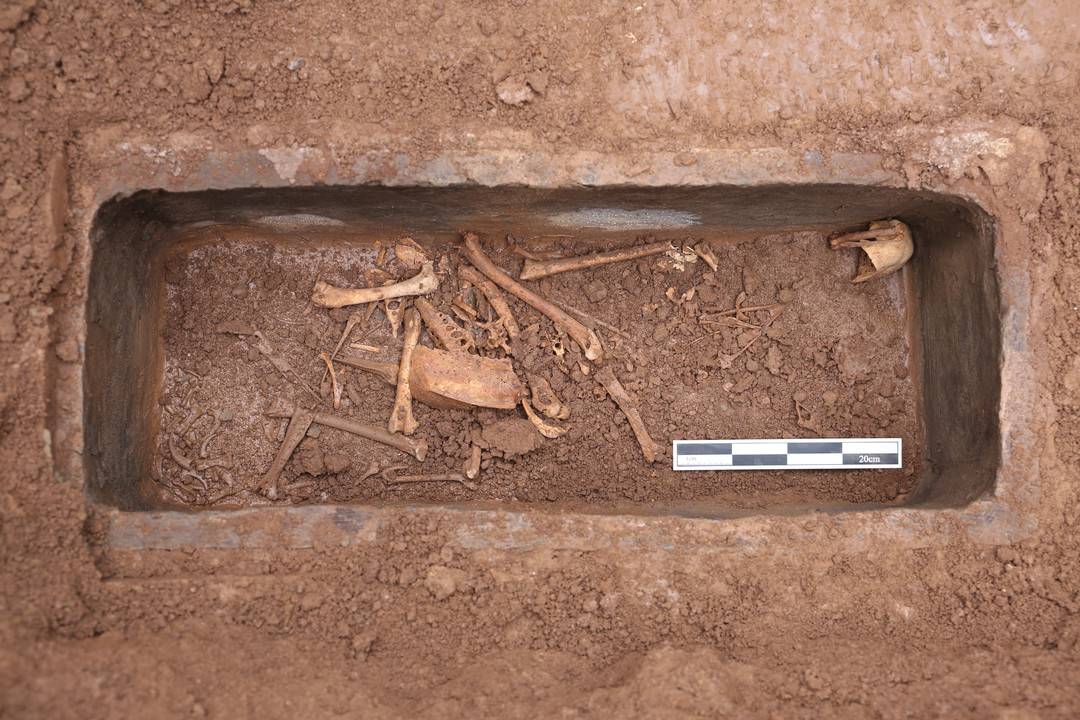Archaeological China | The animal bones unearthed from Ba Ling, or the "Royal Garden" of the Emperor Hanwen
Author:Cover news Time:2022.06.23
Cover news reporter Liu Kexin picture provided by the respondent
From silence to hustle and bustle, return to peace. Since December 2021, from the announcement of the Great Tomb of Xi'an Village in Shaanxi, it has been identified as the Emperor Hanwen Buling, corrected the wrong recognition of nearly a thousand years, and was selected as "Top Ten Archaeological Discovery of the National Top 2021". It was dispersed again that the excavation research work of the Millennium Emperor's Mausoleum has been gradually carried out by its own rhythm.

Aviation panoramic view of Baling Ling District (Dou Queen's Mausoleum, Jiangcun Tomb Discovery Point, Nanling)
What is the latest trend of this Emperor Western Han Emperor's Tomb that was determined in the end? On June 12, the cover journalist contacted Cao Long, a research librarian of the Shaanxi Provincial Institute of Archeology and the archeological calendar of the Grand Tomb of Jiangcun. All kinds of cultural relics unearthed from the nanling pits were organized in indoor information. Including the fighting and repair of unearthed pottery utensils; rust removal protection of metal utensils, and carried out component detection and analysis at the same time; bone reinforcement and species identification of animal bones unearthed from small hidden pits, and so on. These tasks help us have a deeper understanding of the connotation of the Emperor's Mausoleum and the funeral customs of the Western Han Dynasty. Cao Long revealed that in the next step, the identification results of the animal bones excavated in the large tombs of Jiangcun and the Queen Queen Mother of the Bo Tai will be released uniformly.
A total of 3 outbound pit unearthed animals bones were unearthed in Baoling and nearby

Jiangcun Da Tomb K32 Horse Bone unearthed
As the tomb of Jiangcun was recognized as the Emperor Hanwen Buling, the names of the 11 Emperor's Mausoleum of the Western Han Dynasty were all determined. People who have a renewal and more comprehensive understanding of the Emperor Hanwen, the emperor who is benevolence, filial piety, and frugality in Chinese history. At the same time, it also fills the key part of the development of the Western Han emperor's tomb and make up for the development of the western Han emperor's mausoleum system development system. Related research.
In the design of the mausoleum, the literature clearly records that the Emperor Hanwen "governed the Tombs with tiles, and must not be decorated with gold, silver, bronze tin, does not cure grave, wants to save people, and do not bother the people. Change. "But as the tomb of the emperor, the Tombs still is still the funeral specification of" reduction of gifts and no reduction ". The animal bones excavated from the small southwestern hills in the southwest of the Grand Tomb of Jiangcun also illustrate this. Cao Long introduced that in the field archeological work of the Batling site, there are three main pits of animal bones unearthed.

A group of painted plastic pottery figurines unearthed from Nanling
First, it is a square outer hidden pit numbered in the southwestern corner of Jiangcun's tomb. In addition to the pony of each pit, there is a pottery pot and a plastic pottery figurine. According to the strata excavated by field archeology, this kind of pit should be done in the early days of the construction of the cemetery than other hidden pits. It is speculated that the funeral horses may be used for sacrifice.
Second, it is a small hidden pit of about 800 meters southwest of Jiangcun Tomb. The small hidden pit here was discovered and discovered and excavated in the basic construction of farmland water conservancy in July 1966. There are 8 rows of east -west lines, 1 in each row, and 11 pieces. At that time, it was considered to be the funeral pit of Queen Dou Queen's Mausoleum. The burial utensils cleaned from it include pottery coffin or brick bar. The bones are initially identified. There are sheep, horses, pigs, dogs, chickens, goose, cranes, etc. The unearthed pots are also contained in grains. "After the tomb of Jiangcun was discovered, these small foreign hidden pits were found closer to Ba Ling and should be a hidden pit for Ba Ling. At present, we are discovering more than 20 seats and cleaning, and the identification of bones is still ongoing. The data is very helpful for us to know the nature of such a hidden pit. "Cao Long introduced.
Third, it is a small outer hidden pit in the northwest corner of the Nanting Cemetery of Hanwen Emperor Bo Ling's mother, the mother of the Emperor Hanwen. Since 2017, the Hanling Archaeological Team has conducted detailed archeological exploration work on the area. A total of about 380 pits were found, and 39 were excavated this time. Animals that are initially identified are elk, golden monkeys, red -crowned cranes, and tortoises.
Bohmons have unearthed bones such as giant pandas, red -crowned cranes
Nanling, the tomb of the Queen Mother of the Western Han Dynasty, is located on the east suburbs of Xi'an. Because Lu Hou and Han Gaozu Liu Bang were buried in Changling, the Queen Mother Bo was buried in a place similar to that of Emperor Hanwen. In June 1975, when the local villagers built a reservoir, several rectangular pits were found near Nanling. At that time, the Shaanxi Provincial Institute of Archeology at that time discovered and cleaned up the area.

Animal bones unearthed from Nanling Small Tibetan Pit
In this excavation and cleaning, bricks, pottery coffin, wooden bar (wooden) and animal bones were found. Among them, small animal bones have been decaying and have long been unsatisfactory. After being identified by the large animal bones that can be distinguished, rhinos and giant pandas were found. The pit of the big panda skull number is K3, because this pit has experienced disturbance, and the trunk part of the giant panda no longer exists. After identification, the panda belongs to an adult individual. From the perspective of the skull, it is not much different from the living variety.
"Said the Words" said, "It is like a bear, yellow and black, in the Shu in Shu." So does the panda bring tribute from Shu to Shaanxi? Cao Long said that in fact, it is not necessarily: "The Guanzhong of the Qin and Han dynasties, gentle and rainy, Gangfuqiu and the riverside have dense shrub belts and bamboo bushes. Rough '.' Hubei and Duzhu Forest '' Weichuan Thousand Mi Bamboo '. This geographical environment provides necessary conditions for the survival of giant pandas. Grand Panda, as the queen queen of the Han Dynasty, is completely possible from the local area. ","
Some people imagined that the queen mother loved panda in the bone of the big panda unearthed from Nanling, and deduced the boom of breeding giant pandas at the time. But Cao Long told reporters that there were no relevant literature records. In addition, the bone of the bones unearthed from Nanling also does not mean that the queen queen herself likes the giant panda very much. "Judging from the current number of hidden pits and the identified animal species, it is still the nature of the Royal Garden, not to be buried alone because of personal preference. The south even worshiped outside the territory. "
The Han Dynasty people "die like a life" may be a glimpse of the Royal Garden
The personnel of the Han Dynasty were dead, and they had a custom of the dead in the underground world according to their lifestyle habits and living costs. In the "Salt and Iron Theory", Xuan Kuan said: "Today, the thick capital is hidden, and the instruments are used like people." The burial cultural relics and grains, poultry and livestock excavated arranged archeological excavations all reflect this. Cao Long said, "As the tomb of the emperor level, the hidden pits of such buried animals should symbolize the Royal Garden, which is an animal reserve in another world or enjoying or using." In addition, in ancient times, in ancient times, in ancient times, in ancient times, in ancient times, in ancient times, in ancient times, in ancient times, in ancient times, in ancient times, in ancient times, in ancient times, in ancient times, in ancient times, in ancient times, in ancient times Animal bone funeral is also a reflection of wealth and power. Therefore, although Emperor Hanwen stayed in the history of frugality, from the perspective of the animal bones discovered, his tomb still adopted the specifications of "reducing gifts and no reduction".
"This kind of burial birds and beasts symbolize the Royal Garden's practice for a long time, but with the development of the cemetery planning form, different forms have been shown." It was believed that the tomb of Qin Shihuang's grandmother, the queen queen queen, had a large number of treasures and other beasts buried in the hidden pit in the outside of her peripherals. At the same time, there is also a water bird pit in the hidden pit of Emperor Qin Shi. These all show that the royal mausoleum uses the custom of animals for funeral.
What are the animal bones excavated from the tomb of Jiangcun? What is the "Royal Garden" of the emperor who created the first emperor in the history of our country? Perhaps we will be known as the results of the archeological research work of the Great Tomb of Jiangcun.

- END -
2022 The Cultural Examination of the Army Soldiers Examination Cultural Examination Examination
Pass the weekend in the children's museum

On June 19th, in the Shishi Museum, many citizens took their children to visit the...